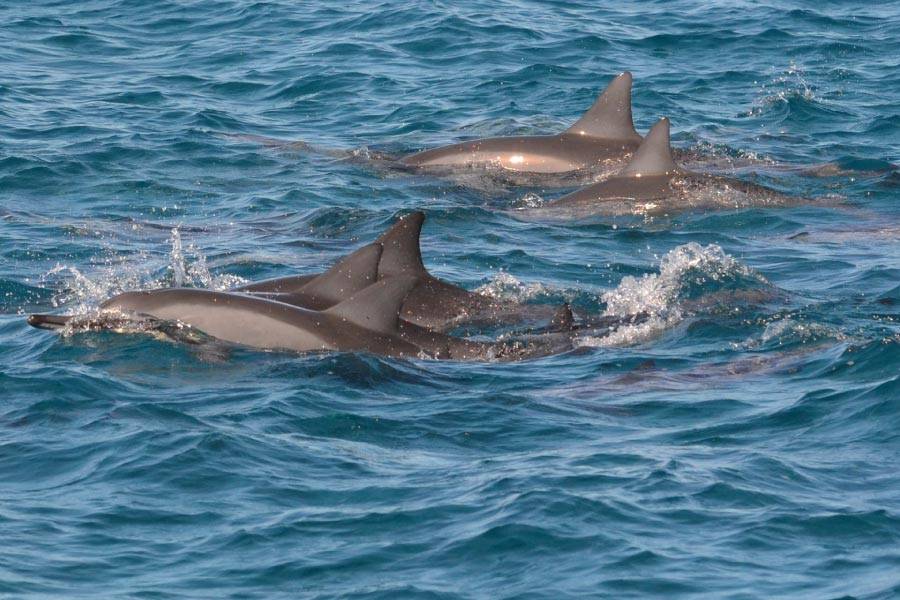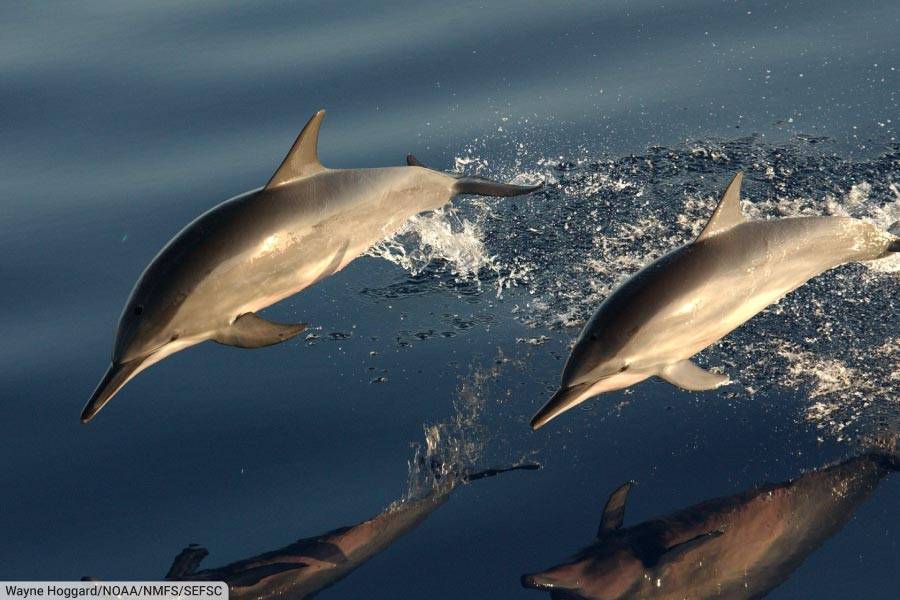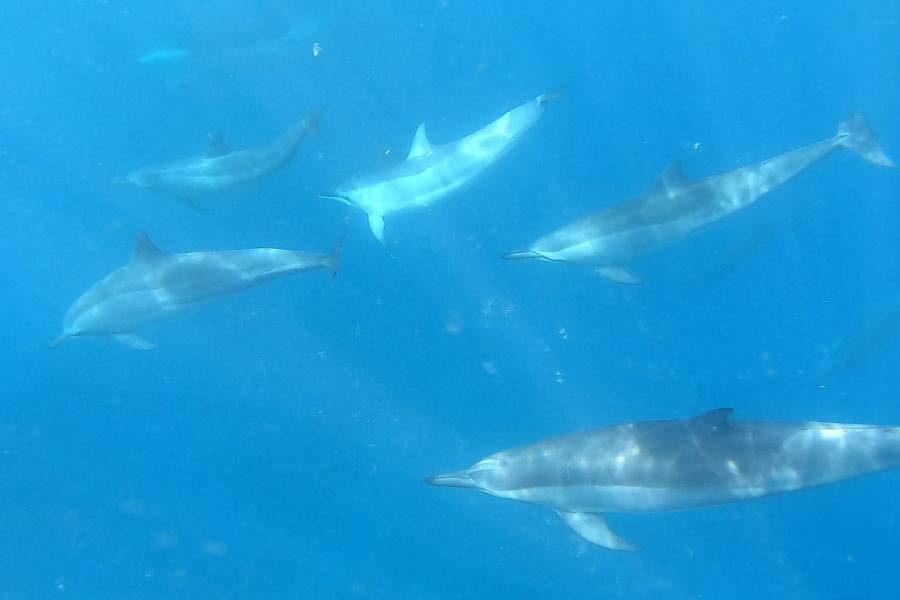
The spinner dolphin (Stenella longirostris) is a small dolphin species named for its acrobatic spinning jumps. On this page is a complete guide to this characterful cetacean…
Page Index
- Spinner Dolphin Stats
- What is a Spinner Dolphin?
- Physical Appearance
- Where Found
- Diet
- Family And Related Species
- Life Cycle & Lifespan
- Why Does The Spinner Dolphin Spin?
- Is the Spinner Dolphin Endangered?
- Discover More With Active Wild
Related Pages on Active Wild
- Discover more about cetaceans on this page: Cetaceans – A Complete Guide To Whales, Dolphins and Porpoises
- You can see pictures and facts on EVERY species of dolphin on this page: Types of Dolphins
Spinner Dolphin Stats

- Scientific Name: Stenella longirostris
- Infraorder: Cetacea
- Parvorder: Odontoceti (toothed whales)
- Family: Delphinidae
- Length: 1.3 to 2.4 meters (4.3 to 7.9 feet)
- Weight: 55 to 75 kg (120 to 165 lbs)
- Where found: Tropical and subtropical oceans worldwide, including the Atlantic, Indian, and Pacific Oceans
- IUCN Conservation Status: Least Concern
What is a Spinner Dolphin?
The spinner dolphin (scientific name Stenella longirostris) is a small, slender cetacean renowned for its impressive acrobatics, in particular its spinning leaps above the water’s surface, from which it derives its common name.
Spinner Dolphin Video
You can see the spinner dolphin performing its characteristic acrobatics in the video below:
What Does The Spinner Dolphin Look Like?
The spinner dolphin has a tri-colored pattern featuring a dark gray back, light gray sides, and white undersides, with a slender and elongated beak that differentiates it from many other dolphin species. The species’ color and markings vary slightly depending on subspecies and location in which it is found.

Where are Spinner Dolphins Found?
The spinner dolphin is a cosmopolitan species, inhabiting warm, tropical oceans around the world.
The species is commonly found in off-shore tropical waters in the Atlantic, Pacific, and Indian Oceans, especially in shallow waters near coastlines and islands.
Notably, spinner dolphins often return to specific rest sites close to shore during the day, venturing further out at night to feed.

Spinner Dolphin Diet
Spinner dolphins predominantly feed on small, mid-water fish and squid, with some regional variation in their diet depending on the available prey species.
The species is known for its nocturnal feeding habits, hunting in deeper waters at night when many of its prey species rise from the depths.
Spinner Dolphin Family And Related Species
The spinner dolphin belongs to the oceanic dolphin family Delphinidae. This family, which is home to the majority of dolphin species, is part of a larger group, the parvorder Odontoceti, a group of marine mammals known as toothed whales.
Odontoceti is one of two main divisions within the infraorder Cetacea, the group that is home to all whales, dolphins and porpoises.
(The other major cetacean group is Mysticeti, whose members, known as baleen whales, lack teeth, and instead filter small animals from the water using comb-like baleen plates.)
You can find out more about cetaceans on this page: Cetaceans – Complete Guide
The spinner dolphin is a member of the genus Stenella, which is also home to the species’ closest relatives, which include the clymene dolphin, striped dolphin, and the spotted dolphins.
Four spinner dolphin subspecies are currently recognized, each displaying slight differences in size, shape, and coloration due to their geographical distribution:
Spinner Dolphin Subspecies
- Eastern spinner dolphin, S. l. orientalis: Tropical eastern Pacific.
- Central American / Costa Rican spinner dolphin, S. l. centroamericana: Tropical eastern Pacific.
- Gray’s / Hawaiian spinner dolphin, S. l. longirostris: Central Pacific Ocean, particularly around Hawaii
- Dwarf spinner dolphin, S. l. roseiventris: Gulf of Thailand
Spinner Dolphin Life Cycle & Lifespan
The female spinner dolphin gives birth after a gestation period lasting approximately 10 months. At birth, the calf is about 80 centimeters long (2.6 feet) and sticks close to its mother, often swimming in her slipstream to ease its movement.
The mother feeds the calf with her milk, and continues to do so until the calf is around 1-2 years of age.
A female spinner dolphin reaches sexual maturity between 4-7 years, while a male matures between 7-10 years. Once mature, a female typically gives birth to a calf every 2-3 years.
Lifespan
A spinner dolphin can live for over 20 years in the wild, although the exact lifespan varies. Threats to its survival include predation by larger marine creatures (such as sharks and killer whales), entanglement in fishing gear, habitat degradation, and marine pollution.
Why Does The Spinner Dolphin Spin?
While the precise reasons for the spinning behavior of spinner dolphins aren’t entirely known, several theories have been proposed:
- Communication: Some researchers believe spinning may be a form of communication between dolphins. The splash created when the dolphin re-enters the water after a spin could signal information to other dolphins, such as warning of danger or indicating the presence of food.
- Parasite Removal: Spinning and leaping might help dislodge parasites from the dolphin’s skin, maintaining their health and comfort.
- Play: Dolphins are highly intelligent animals known for their playful behavior. Spinning could simply be a way for spinner dolphins to have fun and enjoy themselves.
Is the Spinner Dolphin Endangered?
The spinner dolphin is not endangered, and is currently (August 2023) listed by the IUCN as “Least Concern”. However, the species faces various threats, including accidental capture in fishing gear (known as bycatch), marine pollution, and habitat loss.
Discover More With Active Wild
You can find out more about dolphins and related animals on the following pages on Active Wild:
Discover more about cetaceans on this page: Cetaceans – A Complete Guide To Whales, Dolphins and Porpoises
You can see pictures and facts on EVERY species of dolphin on this page: Types of Dolphins
You can see pictures and facts on EVERY species of whale on this page: Types of Whales
The post Spinner Dolphin Facts, Pictures, Complete Species Guide appeared first on Active Wild.